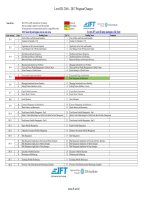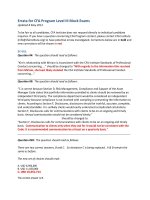Level III learning objectives 2018
Bạn đang xem bản rút gọn của tài liệu. Xem và tải ngay bản đầy đủ của tài liệu tại đây (148.58 KB, 8 trang )
Learning Objectives
CMT Level III - 2018
The Integration of Technical Analysis
Section I: Risk Management
Chapter 1
System Design and Testing
By the end of this chapter you should be able to:
Explain the importance of using a system for trading or investing
Compare and analyze differences between a discretionary and
nondiscretionary system
Describe the mind-set and discipline required to develop and trade with a
system
Explain the basic procedures for designing a system
Describe the role that risk management plays in system design
Identify and evaluate various ways to test a system
Compare and analyze standard measures of system profitability and risk
Chapter 2
Money and Portfolio Risk Management
By the end of this chapter you should be able to:
Calculate and measure risk as it relates to money management
Describe the significance of a martingale betting strategy to trading
applications
Differentiate between diversifiable versus correlated risk
Compare and analyze the various types of stops used to manage risk
Describe how to calculate the minimum capital needed for trading a system
Determine an appropriate percentage of capital to allocate toward one
system
Chapter 3
System Evaluation and Testing
By the end of this chapter you should be able to:
Critique the use of performance and risk metrics based on a given objective
Interpret data from a system test to determine lack of randomness in the
results
Explain the differences of various performance metrics and why one is more
suitable than another for a given objective
Interpret the Sharpe ratio for trading systems, portfolios, and individual
securities
© 2018 CMT Association, Inc.
Chapter 4
Practical Considerations
By the end of this chapter you should be able to:
Explain what checks can be made to verify the validity of daily data
Differentiate between general problems encountered when testing a system
with deeper issues such as the assumptions of the developer
Construct a rule to take advantage of combining the Theory of Runs with the
direction of a trend
Chapter 5
Risk Control
By the end of this chapter you should be able to:
Explain how to measure probability of price change and returns over a given
time frame
Explain how to measure risk factors such as news, volatility, etc.
Interpret calculations of VaR
Compare VaR calculation to confirm selection of stop placement
Calculate the amount of money at risk in a portfolio based on a specified
scenario
Differentiate between risk and performance metrics derived from one of the
following: Sharpe ratio, Information Ratio, Treynor Ratio, Calmar Ratio,
Sortino Ratio
Chapter 6
Statistical Analysis
By the end of this chapter you should be able to:
Differentiate between random and nonrandom trends in data from system
performance
Analyze fat-tailed distributions among returns data
Explain how to measure probability of price change and returns over a given
time frame
Explain how to calculate relative frequency
Derive a sampling distribution
Chapter 7
Hypothesis Tests and Confidence Intervals
By the end of this chapter you should be able to:
Explain why the null hypothesis should be the target of any system
developer’s research
Interpret data used for statistical inference
© 2018 CMT Association, Inc.
Section II: Asset Relationships
Chapter 8
Regression
By the end of this chapter you should be able to:
Identify the assumptions of regression
Differentiate between data from a linear regression and data from a multiple
regression
Chapter 9
International Indices and Commodities
By the end of this chapter you should be able to:
Describe the different international indexes and commodities
Chapter 10 The S&P 500
By the end of this chapter you should be able to:
Describe general correlations noticed between the S&P 500 and International
Indices
Chapter 11 European Indices
By the end of this chapter you should be able to:
Describe general correlations noticed between the European Indices and
other indices or commodities
Chapter 12 Gold
By the end of this chapter you should be able to:
Describe general correlations noticed between Gold and other indices
Chapter 13 Intraday Correlations
By the end of this chapter you should be able to:
Identify the strongest correlations in various timeframes between the listed
index futures in this chapter
© 2018 CMT Association, Inc.
Chapter 14 Intermarket Indicators
By the end of this chapter you should be able to:
Analyze and interpret relative strength of different assets
Analyze and interpret Bollinger Band Divergence signals
Interpret data from multiple regression divergence signals to predict a target
market
Prepare a recommendation or other response based on asset correlation data
Chapter 15 A Unique Way to Visualize Relative Strength
By the end of this chapter you should be able to:
Interpret Relative Rotation Graphs
Explain how Relative Rotation Graphs are an example of a novel approach to
visualizing relative strength
Section III: Portfolio Management
Chapter 16 Fact, Fiction and Momentum Investing
By the end of this chapter you should be able to:
Explain valid reasons for establishing strategies based on momentum
investing styles and momentum-based price patterns
Chapter 17 Analyzing the Macro-Finance Environment
By the end of this chapter you should be able to:
Forecast possible progression of a business cycle model
Explain the relationship between the business and financial cycles
Identify leading, coincident and lagging indicators of economic activity
Chapter 18 Portfolio Risk and Performance Attribution
By the end of this chapter you should be able to:
Explain the differences of various performance metrics and why one is more
suitable than another for a given objective
Interpret the Sharpe and Treynor ratios for individual stocks and portfolios
Explain the characteristics of different alternative investment types and why a
portfolio manager might consider using them
© 2018 CMT Association, Inc.
Section IV: Behavioral Finance
Chapter 19 Behavioral Biases
By the end of this chapter you should be able to:
Explain the difference between cognitive errors and emotional biases
Recognize the main characteristics between cognitive errors and information
processing errors
Identify the implications of each cognitive or emotional bias listed in this
chapter
Chapter 20 Investor Psychology
By the end of this chapter you should be able to:
Understand how trends and market tops and bottoms develop with respect
to various psychological and emotional biases
Identify the behavioral elements associated with trending action and the
underlying reasons for why trends tend to persist
Identify the behavioral elements associated with consolidations and the
underlying mechanisms responsible for ranging action and breakouts
Identify the behavioral elements associated with market reversals and the
underlying reasons for irrationality at tops and bottoms
Chapter 21 Are Two Heads Better Than One?
By the end of this chapter you should be able to:
Explain three possible means for reducing group biases
Chapter 22 The Anatomy of a Bubble
By the end of this chapter you should be able to:
Explain and recognize evidence for the five stages of a bubble
Chapter 23 De-Bubbling: Alpha Generation
By the end of this chapter you should be able to:
Identify and explain the three cross-section strategies that should benefit
from a de-bubbling/deflationary period
© 2018 CMT Association, Inc.
Chapter 24 Behavioral Techniques
By the end of this chapter you should be able to:
Identify the three major time frames in which the American media could be
viewed as providing trading signals
Using the Volatility Ratio, compare the volatility of an event day in a stock to
most other days in the same stock
Summarize the results of event studies referenced in this chapter
Apply the guidelines for reading the Commitment of Traders reports into a
rule for a trading system or investing methodology
Section V: Volatility Analysis
Chapter 25 The VIX as a Stock Market Indicator
By the end of this chapter you should be able to:
Contrast different measures of volatility
Interpret changes in volatility as a signal useful for forecasting
Explain how volatility can be an integral part of a market forecast
Chapter 26 Hedging with VIX Derivatives
By the end of this chapter you should be able to:
Identify the subcomponents of portfolio volatility
Explain how portfolio volatility may be affected by diversification
Chapter 27 Advanced Techniques
By the end of this chapter you should be able to:
Analyze the relationship between a system’s entry signals and changes in
market volatility
Distinguish whether a system’s entry signal should be filtered based on
liquidity
Calculate the expected move of an index or security based on volatility
measures
Explain the basics of using Fractal Efficiency, Chaos Theory or genetic
algorithms in trading
Explain the basics of using Neural Network (Machine Learning) programming
to trade with market data
© 2018 CMT Association, Inc.
Section VI: Classical Methods
Chapter 28 Pattern Recognition
By the end of this chapter you should be able to:
Analyze potential patterns in price data and describe why they may be valid
as a trading signal
Analyze potential trading opportunities based on gaps in price data
Distinguish those signals based on gaps that are likely to be worthwhile
trading signals from those which are not likely to be worthwhile
Chapter 29 Multiple Time Frames
By the end of this chapter you should be able to:
Demonstrate that you can evaluate price and chart data using one of the
three multiple time frame methods described in this chapter
Explain two benefits for using Multiple Time Frames in trading
Chapter 30 Candlestick Analysis
By the end of this chapter you should be able to:
Understand the significance of various Japanese candlestick patterns and how
to use them to pinpoint reversals and breakouts in the market
Describe the difference between reversal and continuation candlesticks
Identify and differentiate between reliable and unreliable patterns by
referencing the 10 important price action guidelines
Integrate technical studies to Japanese candlestick charts effectively
Identify the three important trigger levels in Japanese candlestick patterns
Chapter 31 Progressive Charting
By the end of this chapter you should be able to:
Evaluate candle patterns in an unfolding progression
Recognize the implications of candle patterns, windows, support and
resistance as a chart progresses
Interpret candle patterns in the context of recent trends
Chapter 32 Bringing it all together: Real world charts
By the end of this chapter you should be able to:
Interpret support and resistance levels for rising and falling windows
Evaluate risk and reward of a trade based on a given candle pattern setup
Explaining the importance of interpreting candle patterns in a market context
© 2018 CMT Association, Inc.
Chapter 33 Conclusions
By the end of this chapter you should be able to:
Explain why each of the observations listed in this chapter is applicable as a
general guideline of validity to most systems of trading or investment that are
based on technical analysis
Validate a trading system by comparing it to the observations stated in this
chapter
© 2018 CMT Association, Inc.









